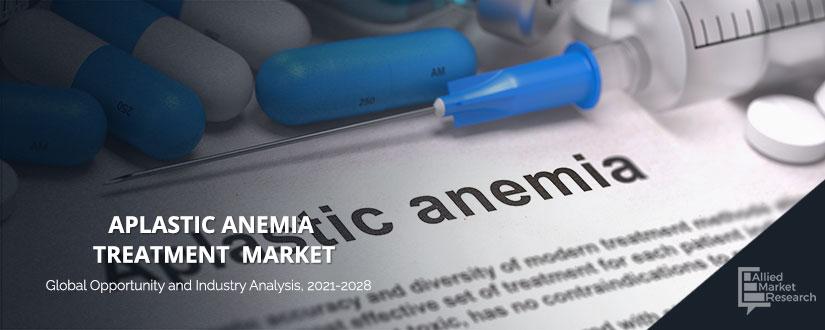Aplastic anemia occurs when the body stops producing enough new blood cells. Patients who suffer from this condition feel more fatigued than normal and are more prone to uncontrolled bleeding and infections. It is a rare and serious condition that can develop at any age. Aplastic anemia can happen slowly and worsen over time or occur suddenly. Treatment of aplastic anemia often includes medications, blood transfusions, or stem cell transplants, also called bone marrow transplant. The most common cause of this condition is autoimmunity. However, other factors that can injure bone marrow include radiation and chemotherapy, exposure to toxic chemicals, and parvovirus infections.
COVID-19 Impact Analysis
COVID-19 is an infectious disease that originated in the Hubei province of the Wuhan city in China in late December. The highly contagious disease, caused by a virus, severe acute respiratory syndrome coronavirus 2 (SARS-CoV-2), is transmitted from human to human. Since the outbreak in December 2019, the disease has spread to almost 213 countries around the globe with the World Health Organization declaring it a public health emergency on March 11, 2020.
Pharmaceutical and biotech companies together with governments around the globe are working to address the COVID-19 outbreak, from supporting the development of vaccines to planning for medicine supply chain challenges. Currently, around 115 vaccine candidates and 155 molecules are in the R&D pipeline. Moreover, commonly used drugs such as hydroxychloroquine have witnessed a dramatic surge in demand for management of COVID-19. Such high demand for these drugs has presented huge opportunities for manufacturers of COVID-19 management drugs, as many developed countries are facing a shortage of these drugs. Thus, the pharmaceutical and biotechnology industries are expected to witness significant growth in the future, owing to the demand for vaccines and treatment drugs for COVID-19.
However, with COVID-19, the supply chain of raw material required to manufacture drugs to treat aplastic anemia has been disrupted in many countries. In addition, the market growth for aplastic anemia treatment is also declining as manufacturers of these drugs have slowed down their production, owing to the pandemic. This, in turn, is expected to have a significant impact on the aplastic anemia treatment market.
Top Impacting Factors
- Increase in prevalence of blood disorders across the globe is anticipated to positively influence the global aplastic anemia treatment market during the forecast period.
- Rise in awareness of conditions such as aplastic anemia and other related blood disorders can also fuel growth of the market. With increase in awareness patients can seek necessary treatments and therapies that can help their conditions with aplastic anemia get better.
- With a rise in population and increase in disposable income in developed nations, consumers tend to have better purchasing power, owing to which they can invest in best treatment options for aplastic anemia. This, in turn, is expected to propel the aplastic anemia treatment market growth.
- High cost of treatment options for aplastic anemia hinders growth of the aplastic anemia treatment market in developing nations. For instance, cost of a bone marrow transplant is around $300,000, which is unaffordable for many patients.
Key Market Trends
In November 2018, the Food and Drug Administration (FDA) approved Promacta, which is the first-line treatment for aplastic anemia. It was launched by Novartis AG. Novartis AG also received approval for Revolade, which is used for aplastic anemia treatment in adult patients. In September 2016, an additional data application was submitted by Regen BioPharma Inc., for its orphan drug, HemaXelerate. HemaXellerate comprise fat tissue cells of patients and helps induce a response in their body to heal bone marrow and restore the ability to generate new and healthy blood cells. North America holds a major share of the aplastic anemia treatment market, owing to high prevalence of blood disorders. With the presence of major market players, this region is expected to grow further during the forecast period.
Asia-Pacific also has many opportunities for growth in the aplastic anemia treatment market. This region attracts a huge number of global patients as many countries in Asia offer low-cost treatments and surgery options for aplastic anemia.
Key Benefits of the Report
- This study presents the analytical depiction of the aplastic anemia treatment industry along with the current trends and future estimations to determine the imminent investment pockets.
- The report presents information related to key drivers, restraints, and opportunities along with a detailed analysis of the aplastic anemia treatment market share.
- The current market is quantitatively analyzed to highlight the aplastic anemia treatment growth scenario.
- Porter’s five forces analysis illustrates the potency of buyers & suppliers in the market.
- The report provides a detailed analysis depending on competitive intensity and how the competition will take shape in the coming years.
Questions Answered in the Aplastic Anemia Treatment Report
- Which are the leading players active in the aplastic anemia treatment market?
- How is each segment of the market expected to grow during the forecast period?
- What are the adoption trends for the aplastic anemia treatment market in emerging economies and established economies across the world?
- What are the current trends that will influence the market in the next few years?
- What are the driving factors, restraints, and opportunities of the market?
- What future projections would help in taking further strategic steps in the market?
- What are the impacts of COVID-19 on the industry?
- What is aplastic anemia?
- What are the current and predicted trends of the market?
Aplastic Anemia Treatment Market Report Highlights
| Aspects | Details |
| By Treatment Type |
|
| By Disease Type |
|
| By End User |
|
| By Route of Administration |
|
| By Region |
|
| Key Market Players | Amgen, Inc., Shire, Inc., Bluebird Bio, Inc., Kyowa Kirin Co., Ltd., Pfizer Inc., CSL Limited, Novo Nordisk AS, Bayer AG, Novartis Pharmaceuticals Corporation, Octapharma AG, GlaxoSmithKline Plc. |
Loading Table Of Content...




